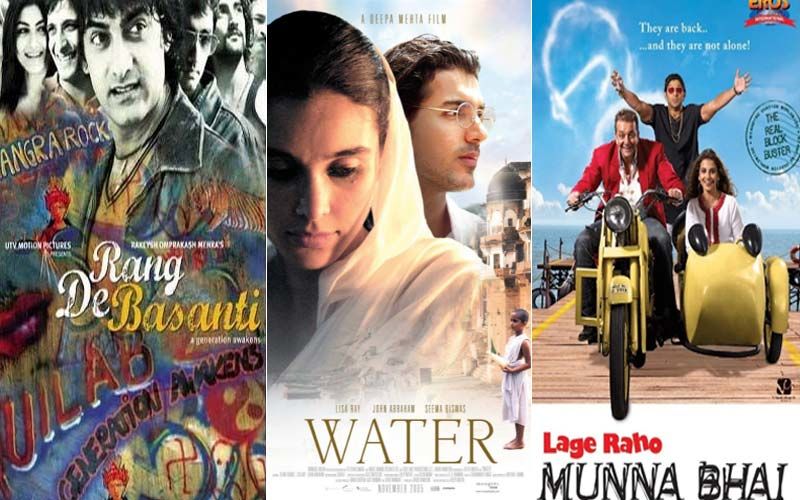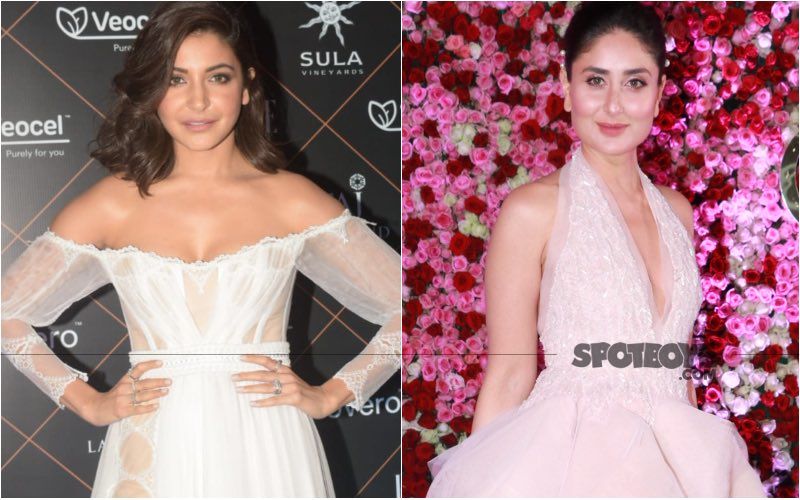Rang De Basanti, Water, Lage Raho Munnabhai: 3 Interesting Movies To Watch While You’re Stuck At Home During Lockdown- PART 7
We bring you another list of movies to watch while you’re stuck at home amid lockdown due to COVID-19; check it out!

1. Rang De Basanti (2006): In every sense of the word Rang De Basanti is a winner. Its aesthetic values and characterizations fill you with amazement and elation. It’s a gloriously triumphant look at today’s lives. And yet it audaciously takes a sweeping arching look at history for answers to the Big Question.Where has today’s generation gone wrong? Why is the nation so inured in corruption? And why are we so enamoured of the stagnant status quo?Are we scared to sweep the garbage? Lofty thoughts, often swept by popular art under a carpet of cynicism. Not this time! Rakeysh Mehra achieves a stirring and stunning synthesis of social relevance and mesmeric storytelling. From the start we are led into a world where youthful aspirations are aligned to the socio-political reality of a country on the brink. Rang De Basanti is a film on the edge. It jumps and careens across lives prancing on the precipice of the contemporary and the historical.
“Is desh ka kuch nahin hoga!” How many times have we said this to ourselves and to others Mehra’s protagonists , an assorted bunch of collegians and post-college friends, are played with amazingly casual grace by Aamir Khan(DJ) , Siddharth(Karan) , Sharman Joshi(Sukhi), Kunal Kapoor (Aslam) and Soha Ali Khan(Sonia). Into their world of endless fun and aimless aspirations comes a pretty and brainy British girl named Sue(the lovely and graceful debutant Alice Patten). Prompted by her colonist-grandfather’s diary, Sue wants to make a film on the life of the legendary Indian freedom fighters—you know, Bhagat Singh, Chandrashekhar Azad, the works.And guess what? Sue wants to cast DJ and gang as the revolutionaries! The guffaws and the giggles that follow Sue’s dreams fade away, as this youthful brigade of adrift dreamers gets down to the ritual of acquainting itself with Indian history.Rang De Basanti dares to point fingers , and tells us where we’ve gone wrong. It isn’t only a film about the education of a moorless generation, it’s also an outstandingly accomplished piece of cinema.
Mehra proves himself an outstanding racounteur and technician. With the deft and diligent editor(P.S Bharathi) tailoring the past to merge fluently into the present, and Binod Pradhan’s camera capturing Delhi and its surroundings as a character rather than cities , Mehra’s job of bringing the past into the same line of vision as contemporary India , is rendered inevitable and unforgettable.Rang De Basanti is an extremely ambitions film. It tries to educate the generationsIndependent India who have brought the country to its current crisis of moral and political corruption. But it never gets hysterical or polemical, thanks to Prasoon Joshi and Rensil D Silva’s conversational yet penetrating dialogues. Mani Rathnam attempted the same theme in a different less dramatic light in Yuva.
Rakeysh Mehra goes many steps ahead. He blends historical events from the past (e.g the massacre by Britishers at Jallianwala Bagh) with today’s newspaper headlines(the MIG war- planes scam) . The film-within-a-film format(earlier attempted in films as diverse in language and intent as Karel Reisez’s The French Lieutenant’s Woman and Mrinal Sen’s Akaler Sandhane) gives the narrative the texture of a life lived in layered luminosity.Not for a second does Rakeysh Mehra falter in his vision. The story of today’s youth , their lack of connectivity with their past , and the prevalent moral degeneration pf the nation , could quite easily have lapsed into a holier-than-thou jingoistc exposition.
Rang De Basanti works wonderfully and exceptionally as both a political parable and a spanking story on the scars of the times. In the fusion of fact and fiction, style and content the film is both teasing and tempting . While you applaud the filmmaker’s immense stronghold over his storytelling the characters never seem dwarfed by their ambience.You come away , haunted and bewildered by the issues that Mehra raises without letting his story suffer in the process of linking the modern tale with history. You come away from Rang De Basanti enchanted by the natural verve of its songs and dances, its director’s flair creating fissures and feeling from within the characters rather than imposing creative authority from outside. There’re interludes and visuals in Rang De Basanti which shall remain alive forever. There may be better films . But there will never be another one quite like this one.
2. WATER(2006): Water belongs to that rare category of films that have the power to re-define the parameters of cinema, to re-align the function and purpose of the medium, and to re-structure the way we, the audience look at the motion -picture experience.It’s no coincidence that Deepa Mehta’s heroine is named Kalyani . Lisa Ray as the tragic but irradiant widow seems to echo Nutan’s Kalyani in Bimal Roy’s Bandini.The tragic grandeur that Water wears on its resplendent sleeve is a quality that sets it apart from other reformist dramas. The film has a great deal to say about the plight of socio-economically challenged women, specifically the widows of Varanasi in the 1930s . The burning ghats and the waters that flow from them, symbolize the ashes-and-embers predicament of Deepa’s ashram-bound women….all plagued by the pathos of dereliction , deprivation and yes, prostitution.In telling it like it is, Mehta never filches. When has she ever done that?! Her elemental trilogy(Fire, Earth & Water) reflects a harshly uncompromising sensibility. In Water Mehta doesn’t beautify the brutality of the widows’ existence. There are bouts of humour, dance and music(watch Lisa Ray and little Sarala dance around their dingy room as the rain splashes romantically on the parched streets down below, or the eruption of Holi revelry in the ashram). A quality of luminous lyricism runs through the narration, specially in the romantic interludes between Narayan(John Abraham) and Kalyani(Lisa Ray) which are designed like a modern-day re-working of the Radha-Krishna mythology.
The sheer purity and beauty of the central romance contrasts tellingly with the squalidity of the lives and settings that the plot negotiates with such slender but deft steps.Whether it’s in capturing the layer after emotional layer in this onion of a drama or in juxtaposing sequences of the shimmering river with the run-down ashram, Giles Nuttgen’s camera doesn’t flinch from the beauty and the grime. The cinematography could’ve easily converted the multi-layered character-study into a touristic over-view. Nuttgen takes us into the darkest areas of the human condition to search for the peace that prevails under the panic of existence. And A.R Rahman’s music, his best in (y)ears, uplifts the mood of tragic pathos to the sphere of sublimity. Many moments in Water would comfortably qualify as Pure Cinema. That moment when the oldest woman in the ashram devours a laddoo that she had been craving for all her life could be seen as the most satirically tragic juncture in a film on soci-culturally challenged lives.
Water as the giver and the destroyer…that’s the predominant metaphor that cuts through heart of the fragile but for tale. Each time we see the porcelain Kalyani peep out of her dungeon-like window, we know she’s searching for a horizon that most of us never find in our lifetime.Water contours and defines those glazed regions in our history that we would rather not sharp-focus on. In many ways its depiction of the plight of abandoned widows is a metaphor for the condition of women across the world, and also a microcosmic view of the human condition. In one way or another we are all persecuted and haunted. A film like Water comes once in a while to negotiate that seemingly insurmountable space between desire and longing, between love and rituals. As in all works of true art, no character in Water is big or small. They’re all played by actors who know what needs to be done, and how to bridge that gap between delusional reality and illusional artistry.
The fine cast grabs your undivided attention. Seasoned performers like Manorama(playing the head of the ashram she’s a conniving scheming farting mass of vulgarity and self-interest), Seema Biswas(clenched controlled conflicted by fundamentalism and the Gandhian reformist that assails her existence) and Raghuvir Yadav(a whoop as a singing eunuch) blend beautifully with the central love story embodied with supreme sensitivity in the John-Lisa pair.And to think that we always thought of John and Lisa as actors incapable of overcoming their inherent urbanity!It’s Sarala as little Chuhiya whom you’ll find hard to get out of your head. She is the most credible child performer ,on a par with Ayesha Kapoor in Sanjay Bhansali’s Black. Normally children in films respond to adult situations in an unnaturally knowing way. Chuhiya remains a child caught in a frightening world of persecution and perversion.
Like bolts of blue feelings , Deepa Mehta inter-cuts the wretched lives of the characters with glimmers of hope. Even when Mahatma Gandhi makes an unexpected appearance at the end the director doesn’t allow her vision of poetry to be crowded by postures of polemics.While you grieve for these doomed disintegrating lives, you cannot miss the subtext of social reform that underlines their lives. The hallmark of a true work of art is the level of sublimity it achieves in its characterizations while conveying thoughts on the quality of lives. What Deepa Mehta has to say about the plight of women in India 75 years ago remains true to this day. Hopefully things will change before another 75 years pass.Water leaves us with much hope, and some frightening misgivings.
3. Lage Raho Munnabhai(2006): It’s all a “chemical locha”(aberration). Munnabhai meets Mahatma Gandhi and they get along like a house on fire . The prophetic leader from the past has a blast as he tells Munna how to deal with an avaricious builder(Boman Irani) and other ouch-casts of society. It looks like Circuit has competition this time. Even as he remains a fiercely loyal Hanuman to his mentor Munna, Munna this time shifts his loyalties and attention to the lovely RJ Jahanvi and to Mahatma Gandhi who keeps appearing in Munna’s day-time reverie to advise the benign gangster on love life and other vagaries of being human. Munna and Circuit, arguably cinema’s most adorable and roguish reformists since Laurel and Hardy go about the business of generating humour out of the pathos of the human condition. The sequences, all fiercely and famously path-breaking have us in splits.Watch the love-lorn Munnabhai answer a Gandhian quiz on a phone-in radio quiz with the help of kidnapped professors…it’s one of the most comically animated sequences seen in the movies of the new millennium.
To look at Lage Raho Munnabhai as a ‘serious comedy’ is to seriously undermine the motivations and impact of the series(and let’s face it, there’s no getting away from the Munna-Circuit jodi for the producer and director).Playing the sweat-smart ruffians with hearts of cool, Sanjay Dutt and Arshad Warsi bring a chirpy enchantment to their roles. Their parts have hefty hearts. But there’s more. There’s an innocence and a desire to make the world a better place.The Munna-Mahatma dialogues sparkle with satirical wisdom, thanks in no small part to Dutt and Dilip Prabhavalkar(who plays Gandhiji with tongue-in-cheek conviction). The dialogues by Hirani and Abhijeet Joshi constantly probe the festering moral and social system of the nation without getting hysterical on homilies. The individual scenes make light of national issues without ever trivializing the cult of the conscience.At heart—and boy, does this film have it in plenty!—Lage Raho Munnabhai is a parable on love and companionship. Whether it’s Munnabhai’s bonding with his faithful companion Circuit(watch the two actors turn that potentially mawkish sequence at the dockyard into something special) or Munna courting love(Balan) and Gandhism, the narrative dodges false notes by remaining sincere to the characters Every actor gets a chance to special in this enriching take of non-violent protest and radio-activity . But Dutt and Warsi go beyond. Sanjay Dutt proves again that he has shaped up into a fine performer who can mingle poignancy with satire the way Raj Kapoor did in those parables to innocence like Shri 420 and Awara , or like Sunil Dutt did in Milan and Meherbaan.
Warsi manages to steal some scenes from Dutt. Vidya Balan is gloriously glamorous and likeable, though she could’ve toned down those expressions of coy contemporaneity that make her look like a model for cornflakes.
In fact some of the emotional moments like those between Jimmy Shergil and his screen-father Pariskshat Sahni or that flamboyant wedding finale where the bride Diya Mirza tells the truth about her horoscope at the cost of turning her groom away, do not have the emotional impact which one thought they would.Though a wee short of tears, Lage Raho Munnabhai goes a long way in creating an enduring and endearing parable on the importance of being earnest in a world of growing duplicity.
The narrative is so unfailingly heartwarming and the characters so full of human kindness, you wait for the plot to be weighed down by excessive self-importance. The fall never happens. Lage Raho Munnabhai remains true to its characters till the end.One of Munna’s favourite words is ‘daring’. It must also be Raj Kumar Hirani’s favourite word. In a world of extravagant cynicism and rancour he dares to dream of Gandhian peace. When the aggressive Munna turns his other cheek , you wonder if Gandhian values have a place in our heart.They most certainly do have a place in Hirani’s art. Shall we take it up from there?
Image source: Imbd
Image source: Imbd

